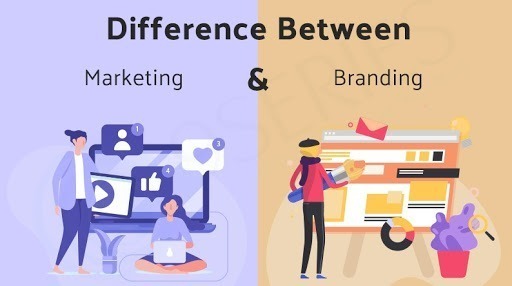Branding and marketing are two important business functions that you can use to increase your profits. This activity is used to gain insight into a product or company. Their relationship is so close that people often don’t distinguish between Marketing Vs Branding. Marketing involves a series of activities that aim to sell a product or service but identify the customer’s needs and start delivering the products.
On the other hand, branding involves activities that capture the hearts of consumers and create product names and images. People not only choose your product over the competition, but they also see your product as the ultimate solution to the problem. This helps build long-term relationships with customers.
In this section, you may discover the necessary differences between marketing and branding.
Marketing Vs Branding
Semantic marketing is a series of activities undertaken by companies to connect buyers and sellers to facilitate the exchange of products or services. Branding allows you to brand your product and allows consumers to identify the company that made the product.
Influence direct customer purchasing decisions. This affects the consumer’s thinking and decision to buy.
- Represents the benefits of dreams
- Push and pull strategically
- Value Increase expectations
- Promotes regular sales and an enduring reputation with ORM services
- Build a demand relationship
- Talk to the target audience’s emotions
Marketing definition
Marketing is defined as a management process that brings businesses and consumers together to exchange goods or services for assessment. It pertains to a range of activities, namely finding, creating, advertising, selling, and providing products or services that are useful to people. It’s not just about delivering and selling products, it’s also about acquiring customers and building customer relationships.
This process includes determining unmet customer needs, determining the size and importance of the target market, determining which departments within it can provide the best service to customers, promoting products or services to forge sales and customer relationships. This includes establishment, etc.
Branding
Do you first need to know what a brand is to understand brand terms? The name, logo, or a combination of both is used to identify a seller’s product or service and distinguish it from the brand. This is a series of activities that allow you to create a unique and memorable name or image of a product or service that will remain in the mind of consumers who use advertising tools to promote Mark.
Branding is a marketing technique that aims to build tremendous influence in the market and attract and retain customers for a long time. It builds trust, increases value, and improves productivity and business experiences.
The main difference between marketing and branding
- Marketing is the collection of activities undertaken by companies to connect buyers and sellers to facilitate the exchange of products or services. On the one hand, branding can give a product a brand name and help consumers identify the company that makes the product.
- Marketing for companies and branding for clients.
- Marketing is used to shape customers and branding is used to build trust and brand loyalty with customers.
- Marketing affects a customer’s immediate response to a purchase. Unlike branding, branding affects the way consumers think, which in turn affects their buying decisions.
- Marketing discloses income from products or services provided by a company. Instead, the brand represents a dream.
- It is a strategic marketing machine and a branding machine.
- Speaking of values, your marketing can promote the expected value and create value
Marketing can be an extraordinary method to stand out enough to be noticed, yet branding is an incredible method to keep their consideration
No matter what industry you are in, you are most likely a competing company in the complex. Plus, marketing is imperative if you want to grab the attention of a customer who is causing a stir.
However, this must be maintained after the customer’s attention has been drawn. This is the root of the branding effect.
People think they want to do business with brands they might be behind and brands they believe in. So it helps to clear marketing confusion and put your brand in front of the right people, but if you want to stay there, people from the brand can get in touch.
In other words, the brand stands out from the competition and says to the customer, “Hey! I’m here! “You need the right marketing strategy, but you need a brand image to build relationships and build and maintain long-term contacts. The first ‘hello’ is next.
Marketing drives sales promote brand awareness and loyalty
Most marketing strategies (SEO content marketing, advertising, etc.) focus on driving results to generate sales.
Wow! If you want your business to be successful, you (of course) need to increase your sales.
However, brand promotion takes a different approach and is long-lasting. If you want to increase sales, branding is not the best solution. But this is the best solution. If you want to increase brand awareness, build positive brand sentiment and build customer loyalty, this is also important (though not more important), but at the same time, it will have a big impact on your ability to drive more sales. sales term. Class.
So, from a business perspective, is marketing seen as a brand-building sprint? It’s like a marathon.
Branding comes first then Marketing comes second
You know the old saying “Chicken first, egg first?” If you are talking about a commercial version of this bill, it could be something like ‘branding or marketing takes precedence.
Brands always go for marketing when it comes to starting a business. And for good reason! You cannot accurately sell an unconventional brand.
Before assessing your marketing strategy wording, focus on building your brand. Who are you? What do you want to market? What are your core values? And above all: how can you communicate with your target group?
Only when you have answers to these questions do you start thinking about marketing. Building a brand is because you understand who you are, who your customers are, and the best way to connect with those customers and develop a marketing strategy to make that happen.
Marketing strategies come and go, but brands remain forever
By the way, don’t get me wrong. You must actively promote the business you want to build a successful business (#captainobollow). However, the strategies you use to promote your business are only temporary. Every marketing strategy has a clear beginning, middle, and end.
Different brands. Wherever you are in the business, you always work hard to define your corporate identity, build brand awareness with your audience, and build deeper and more meaningful relationships with your customers. As your business grows and expands, you must grow and develop your brand.
Marketing strategies (whatever they want) come and go, but what about the brand? The brand is timeless.
The brand affects your team just as it affects your customers
Your team is responsible for drafting and executing your marketing strategy. However, besides (you know … their job), they are less affected by your marketing.
But what about your brand? It’s a completely different story.
The impact of your team’s branding is just as big as the impact on the customer. Just as you need customers to trust your brand to do business with you, so do your employees. When you build a brand that your team can trust, you can focus on the work that makes your teamwork harder. They work hard and sell themselves so their best ideas come to them and your business will thrive.
Therefore, it is your team’s job to develop a marketing strategy, but that is your responsibility.
Brand strategy vs Marketing tactics.
Marketing can help brands, but brands outperform certain marketing activities. It is a brand that survives after marketing has dominated the entire market. It is an idea about a product, service, or organization. It does not matter if you have ever bought the product.
The brand ultimately decides whether you become a loyal customer. Marketing can convince you to buy a particular Toyota car, it may be the first foreign car you will ever own, but it will determine whether you only buy a Toyota car for the rest of your life.
This brand was founded by many people. The actual brand experience is very important. Does the car live up to the reliability of the brand? Do manufacturers continue to push for real quality standards? Do you know what the sales personnel or service center technicians are talking about?
Marketing finds and activates buyers. Branding can turn buyers into loyal customers, supporters, and even evangelists.
It works the same for all types of businesses and organizations. All organizations must be sold (including nonprofits). Sales methods can vary and every step is taken to make or break every brand in your organization. Every idea, every action, every advertising policy Every marketing promotion stimulates or prevents brand loyalty from coming into contact with it. This affects all sales.
Let’s make history as a financial expert. Is this a marketing cost center? A poorly researched and executed marketing activity can certainly be a cost, but it is a worthwhile investment in well-researched and executed marketing, sales, and branding.
Is the brand a cost center? On the surface, yes, but loyalty is rewarding. The pay is in the sales staff, their work is simpler and more efficient, employees live longer and work harder and customers are the spokespersons and supporters of the organization.
Branding is essential to the success of a business or non-profit organization, as well as having a future vision of economic viability or quality employees.
This is the foundation you need for a successful operation. Yes, it is a cost, just like a great employee, financial expert, or innovation in your company or organization. They are cost centers, but what’s expensive is to own them or have unqualified centers.
Is your marketing strategy important?
You can use channels as a marketing strategy to use your limited marketing budget more effectively.
There are marketing strategies and strategies. Much of the marketing is focused on tactical experimentation. It brings different things to the world and different demographic goals to see for effective action. If you do this, you may be spending a lot of money. The idea of this method is to do this until you find an effective marketing funnel. And when you find one, you can do a lot more.
A marketing strategy allows you to use the channels and scaffolding to implement a limited marketing budget more effectively (everyone’s marketing budget is limited). Marketing Strategy Help applies marketing to finance to the correct part of the Wanamaker equation. This means that you cannot mislead non-judgmental customers.
To illustrate this principle in a very simple example of our time, think of the South as Mayor of the Bronx Museum and you’ll see what you get from the first competitive advantage table below. Here, as consumers understand it, their offer has no recognizable value. Therefore, this strategy cannot support the institutional desire to communicate about all the extraordinary art in the exhibition.
Conclusion
Branding is not the same as marketing, it is at the heart of your brand marketing strategy. Building an effective brand requires maintaining stability and clarity in each of the above steps so that the target market can properly appreciate the brand’s personality and value.
The last (very important) thing to remember is that building a brand is not a one-time thing. It is continuous work that permeates your processes, your culture, and the development of your business, and your dedication and loyalty must be reflected in your work. The ultimate analysis is that the real measure of a brand’s success is acquiring loyal customers became brand ambassadors also.



Add a Comment